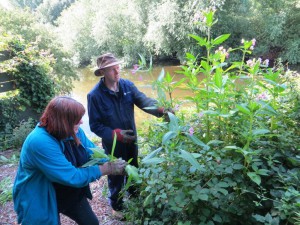
Summer is here. Really. You wouldn’t necessarily think it today as the rain pours down outside the window, but it is. And everything is growing like crazy. A week of work and the site is more green and vibrant than ever; path borders need cutting back, the mower is in action and the veg patch is taking shape. But growing faster than anything else are a couple of alien invaders – non native species that we manage, in order to control their spread across the site, and ultimately to remove them all together.
This week we are having a big push on removing Himalayan Balsam – as part of a citywide push to Banish the Balsam from Leeds! Himlayan Balsam is seen all over the city – especially along the waterways. Its not a hazardous plant (in fact its even edible) but is incredibly invasive – it has explosive seed pods that catapult out seeds up to 8 metres, and grows fast enough to shade out other plants, forming a carpet of sickly sweet selling balsam. It does have its benefits – providing late season forage for bees – in fact lots of beekeepers love it. But its beginning to dominate riverbanks across the country, forcing out native species along the way.
The good thing about Himalayan Balsam is that its quick, easy and safe to remove, and everyone can get involved, making it a great task for volunteers. The plants are shallow rooted and grow tall, so they can be easily pulled up without even having to bend. The important thing to watch out for is that the plant does pull out, rather than snapping off – if it snaps its likley to resprout. The other danger is that they can actually re root after being pulled out, so pilling them up or leaving them in the sun to dry out is the best approach. As long as this is all done before the plant is in flower we know that no new seed is produced, and hopefully that means we are slowly winning the battle…
If you want to come and help us Banish the Balsam – we’ll be doing so with the Skelton Grange Green team on Friday the 6th of June, from 10am until 3pm – come along and help out!
We have successfully reduced the amount of balsam on the Skelton Grange site and are containing it to smaller areas each year. However until everyone upstream does the same we will still have more new plants germinating from seeds that are washed down the river each year…. Part of the process is also to spread the word – and encourage other organisations to do the same. Anyone who finds invasive species can also use the Plant Tracker app to log them, and these records can then be used by organisations such as Yorkshire Wildlife Trust, who are coordinating work on the invasive species along the River Aire catchment. Its an easy way for anyone with a smartphone to get involved and help build up a big picture of where work is needed most.
